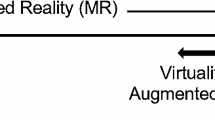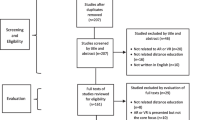Abstract
This study aims to analyze the research outputs of immersive technology in the field of education for the past two decades. To this end, we retrieved 2665 articles that contained 75674 valid references from the Scopus database for the period between 2001–2021. Several structural and temporal metrics were used to find out the emerging topics proposed by the literature of immersive technology in the field of education. Results recorded 869 clusters entailing 2561 nodes and 3372 links. The major clusters identified in our results were related to virtual reality, augmented reality, and virtual worlds. We found that immersion research was grounded on a robust theoretical framework such as constructivism, experiential learning, and cognitive load theory. We found diversified venues of publication in which the immersion literature appeared in 741 peer-reviewed journals. Our results indicate that seven educational technology journals were the most highly co-cited journals where Computers and Education and British Journal of Educational Technology were the most influential journals in terms of quantity and quality of the published articles, recording the highest h-index. Tips and suggestions for future research projects were also highlighted.





Similar content being viewed by others
Data availability
Data are included in the supplementary materials of this article.
References
Araiza-Alba, P., Keane, T., Chen, W. S., & Kaufman, J. (2021). Immersive virtual reality as a tool to learn problem-solving skills. Computers & Education, 164, 104121. https://doi.org/10.1016/j.compedu.2020.104121
Aryadoust, V. (2020). A review of comprehension subskills: A Scientometrics perspective. System, 88, 102180. https://doi.org/10.1016/j.system.2019.102180
Azuma, R. T. (1997). A survey of augmented reality. Presence: Teleoperators & Virtual Environments, 6(4), 355–385.
Barab, S., Thomas, M., Dodge, T., Carteaux, R., & Tuzun, H. (2005). Making learning fun: Quest Atlantis, a game without guns. Educational Technology Research and Development, 53(1), 86–107.
Bendeck Soto, J., Toro Ocampo, D., Beltrán Colon, L., & Valencia Oropesa, A. (2020). Perceptions of ImmerseMe Virtual Reality Platform to Improve English Communicative Skills in Higher Education. In: International Association of Online Engineering.
Brooke, J. (1996). SUS-A quick and dirty usability scale. Usability Evaluation in Industry, 189(194), 4–7.
Brown, J. S., Collins, A., & Duguid, P. (1989). Situated cognition and the culture of learning. Educational Researcher, 18(1), 32–42.
Chabot, S., Drozdal, J., Peveler, M., Zhou, Y., Su, H., & Braasch, J. (2020). A collaborative, immersive language learning environment using augmented panoramic imagery. 2020 6th International Conference of the Immersive Learning Research Network (iLRN).
Chen, C. (2006). CiteSpace II: Detecting and visualizing emerging trends and transient patterns in scientific literature. Journal of the American Society for Information Science and Technology, 57(3), 359–377.
Chen, C. (2014). The citespace manual. College of Computing and Informatics, 1(1), 1–84.
Cohen, J. (2008). Statistical power analysis for the behavioral sciences. Routledge.
Colreavy-Donnelly, S., Ryan, A., O'Connor, S., Caraffini, F., Kuhn, S., & Hasshu, S. (2022). Leveraging immersive technologies to support blended learning post Covid-19. Education Sciences. https://doi.org/10.3390/educsci12070435
Dalgarno, B., & Lee, M. J. W. (2010). What are the learning affordances of 3-D virtual environments? British Journal of Educational Technology, 41(1), 10–32. https://doi.org/10.1111/j.1467-8535.2009.01038.x
Dengel, A., & Mägdefrau, J. (2018). Immersive learning explored: Subjective and objective factors influencing learning outcomes in immersive educational virtual environments. 2018 IEEE International Conference on Teaching, Assessment, and Learning for Engineering (TALE).
Dewey, J. (1938). Experiential learning. Pentice Hall.
Dhimolea, T. K., Kaplan-Rakowski, R., & Lin, L. (2022). A systematic review of research on high-immersion virtual reality for language learning. TechTrends, 66(5), 810–824.
di Lanzo, J. A., Valentine, A., Sohel, F., Yapp, A. Y. T., Muparadzi, K. C., & Abdelmalek, M. (2020). A review of the uses of virtual reality in engineering education. Computer Applications in Engineering Education, 28(3), 748–763. https://doi.org/10.1002/cae.22243
Di Natale, A. F., Repetto, C., Riva, G., & Villani, D. (2020). Immersive virtual reality in K-12 and higher education: A 10-year systematic review of empirical research. British Journal of Educational Technology, 51(6), 2006–2033. https://doi.org/10.1111/bjet.13030
Dickey, M. D. (2005). Three-dimensional virtual worlds and distance learning: Two case studies of Active Worlds as a medium for distance education. British Journal of Educational Technology, 36(3), 439–451.
Emihovich, B., Xu, X., & Arrington, T. L. (2020). SPECIAL-a conceptual framework to support learning in immersive environments. International Journal of Smart Technology and Learning, 2(2–3), 182–197.
Freeman, L. C. (1978). Centrality in social networks conceptual clarification. Social Networks, 1(3), 215–239.
Gruber, A., & Kaplan-Rakowski, R. (2022). The impact of high-immersion virtual reality on foreign language anxiety when speaking in public. SSRN. https://doi.org/10.2139/ssrn.3882215
Halabi, O. (2020). Immersive virtual reality to enforce teaching in engineering education. Multimedia Tools and Applications, 79(3), 2987–3004. https://doi.org/10.1007/s11042-019-08214-8
Hamilton, D., McKechnie, J., Edgerton, E., & Wilson, C. (2021). Immersive virtual reality as a pedagogical tool in education: A systematic literature review of quantitative learning outcomes and experimental design. Journal of Computers in Education, 8(1), 1–32. https://doi.org/10.1007/s40692-020-00169-2
Han, I. (2020). Immersive virtual field trips in education: A mixed-methods study on elementary students’ presence and perceived learning. British Journal of Educational Technology, 51(2), 420–435. https://doi.org/10.1111/bjet.12842
Hew, K. F., & Cheung, W. S. (2010). Use of three-dimensional (3-D) immersive virtual worlds in K-12 and higher education settings: A review of the research. British Journal of Educational Technology, 41(1), 33–55.
Hine, B., Stoker, C., Sims, M., Rasmussen, D., Hontalas, P., Fong, T., Steele, J., Barch, D., Andersen, D., & Miles, E. (1994). The application of telepresence and virtual reality to subsea exploration. Proceeding of the 2nd Workshop on: Mobile Robots for Subsea Environments, International Advanced Robotics Program (IARP), M. J. Lee & R. B. McGee (Eds), Monterey, CA.
Jantakoon, T., Wannapiroon, P., & Nilsook, P. (2019). Virtual immersive learning environments (VILEs) based on digital storytelling to enhance deeper learning for undergraduate students. Higher Education Studies, 9(1), 144–150.
Khukalenko, I. S., Kaplan-Rakowski, R., An, Y., & Iushina, V. D. (2022). Teachers’ perceptions of using virtual reality technology in classrooms: A large-scale survey. Education and Information Technologies, 27(8), 11591–11613. https://doi.org/10.1007/s10639-022-11061-0
Kolb, D. A. (1984). Experiential learning: Experience as the source of learning and development. Englewood Cliffs, NJ: Prentice-Hall Inc.
Luo, H., Yang, T., Kwon, S., Li, G., Zuo, M., & Choi, I. (2021). Performing versus observing: Investigating the effectiveness of group debriefing in a VR-based safety education program. Computers & Education, 175, 104316. https://doi.org/10.1016/j.compedu.2021.104316
Makransky, G., & Petersen, G. B. (2021). The Cognitive Affective Model of Immersive Learning (CAMIL): A theoretical research-based model of learning in immersive virtual reality. Educational Psychology Review, 33(3), 937–958. https://doi.org/10.1007/s10648-020-09586-2
Mashroofa, M. M., Jusoh, M., & Chinna, K. (2019). Research trend on the application of “E-Learning Adoption Theory”: A scientometric study during 2000–2019, based on Web of Science and SCOPUS. COLLNET Journal of Scientometrics and Information Management, 13(2), 387–408.
Mayer, R. (2001). Multimedia learning. Cambridge University Press.
Merchant, Z., Goetz, E. T., Cifuentes, L., Keeney-Kennicutt, W., & Davis, T. J. (2014). Effectiveness of virtual reality-based instruction on students’ learning outcomes in K-12 and higher education: A meta-analysis. Computers & Education, 70, 29–40. https://doi.org/10.1016/j.compedu.2013.07.033
Mohsen, M. A. (2021). A bibliometric study of the applied linguistics research output of Saudi institutions in the Web of Science for the decade 2011–2020. The Electronic Library, 39(6), 865–884.
Mohsen, M. A., & Ho, Y. S. (2022). Thirty years of educational research in Saudi Arabia: A bibliometric study. Interactive Learning Environments. https://doi.org/10.1080/10494820.2022.2127780
Mosher, M. A., Carreon, A. C., Craig, S. L., & Ruhter, L. C. (2022). Immersive technology to teach social skills to students with autism spectrum disorder: A literature review. Review Journal of Autism and Developmental Disorders, 9(3), 334–350. https://doi.org/10.1007/s40489-021-00259-6
Newman, M. E. (2006). Modularity and community structure in networks. Proceedings of the National Academy of Sciences, 103(23), 8577–8582.
Parmaxi, A., & Demetriou, A. A. (2020). Augmented reality in language learning: A state-of-the-art review of 2014–2019. Journal of Computer Assisted Learning, 36(6), 861–875. https://doi.org/10.1111/jcal.12486
Parong, J., & Mayer, R. E. (2021). Learning about history in immersive virtual reality: Does immersion facilitate learning? Educational Technology Research and Development, 69(3), 1433–1451. https://doi.org/10.1007/s11423-021-09999-y
Parsons, S., Mitchell, P., & Leonard, A. (2004). The Use and Understanding of Virtual Environments by Adolescents with Autistic Spectrum Disorders. Journal of Autism and Developmental Disorders, 34(4), 449–466. https://doi.org/10.1023/B:JADD.0000037421.98517.8d
Pears, M., & Konstantinidis, S. (2022). The future of immersive technology in global surgery education. Indian Journal of Surgery, 84(1), 281–285. https://doi.org/10.1007/s12262-021-02998-6
Radianti, J., Majchrzak, T. A., Fromm, J., & Wohlgenannt, I. (2020). A systematic review of immersive virtual reality applications for higher education: Design elements, lessons learned, and research agenda. Computers & Education, 147, 103778. https://doi.org/10.1016/j.compedu.2019.103778
Seymour, N. E., Gallagher, A. G., Roman, S. A., O’brien, M. K., Bansal, V. K., Andersen, D. K., & Satava, R. M. (2002). Virtual reality training improves operating room performance: Results of a randomized, double-blinded study. Annals of Surgery, 236(4), 458.
Sofyan, D., Abdullah, K. H., & Hafiar, H. (2022). The philosophy of sport and physical education: Four decade publication trends via scientometric evaluation. Physical Education Theory and Methodology, 22(3), 437–449.
Stojšić, I., Ivkov-Džigurski, A., & Maričić, O. (2019). The readiness of geography teachers to use mobile devices in the context of immersive technologies integration into the teaching process. Geographica Pannonica, 23(2), 121–133.
Suh, A., & Prophet, J. (2018). The state of immersive technology research: A literature analysis. Computers in Human Behavior, 86, 77–90.
Tang, K.-Y., & Tsai, C.-C. (2016). The Intellectual Structure of Research on Educational Technology in Science Education (ETiSE): A co-citation network analysis of publications in selected journals (2008–2013). Journal of Science Education and Technology, 25(2), 327–344. https://doi.org/10.1007/s10956-015-9596-y
Tang, Y. M., Chau, K. Y., Kwok, A. P. K., Zhu, T., & Ma, X. (2022). A systematic review of immersive technology applications for medical practice and education - Trends, application areas, recipients, teaching contents, evaluation methods, and performance. Educational Research Review, 35, 100429. https://doi.org/10.1016/j.edurev.2021.100429
Van Eck, N., & Waltman, L. (2010). Software survey: VOSviewer, a computer program for bibliometric mapping. Scientometrics, 84(2), 523–538.
Vygotsky, L. S., & Cole, M. (1978). Mind in society: Development of higher psychological processes. Harvard University Press.
Wu, B., Yu, X., & Gu, X. (2020). Effectiveness of immersive virtual reality using head-mounted displays on learning performance: A meta-analysis. British Journal of Educational Technology, 51(6), 1991–2005. https://doi.org/10.1111/bjet.13023
Xu, X., Kang, J., & Yan, L. (2022). Understanding embodied immersion in technology-enabled embodied learning environments. Journal of Computer Assisted Learning, 38(1), 103–119. https://doi.org/10.1111/jcal.12594
Yan, L., & Kwok, A. P. K. (2021). Teaching Liberal Education Using Virtual Reality. 1st International Conference on Education: Current Issues and Digital Technologies (ICECIDT 2021).
Acknowledgements
The authors are thankful to the Deanship of Scientific Research at Najran University for funding this work under the Distinguished Research Funding Program grant code NU/DRP/SEHRC/12/16.
Author information
Authors and Affiliations
Corresponding author
Ethics declarations
Competing interest
The authors declare that they have no conflict of interest.
Additional information
Publisher's note
Springer Nature remains neutral with regard to jurisdictional claims in published maps and institutional affiliations.
Supplementary Information
Below is the link to the electronic supplementary material.
Rights and permissions
Springer Nature or its licensor (e.g. a society or other partner) holds exclusive rights to this article under a publishing agreement with the author(s) or other rightsholder(s); author self-archiving of the accepted manuscript version of this article is solely governed by the terms of such publishing agreement and applicable law.
About this article
Cite this article
Mohsen, M.A., Alangari, T.S. Analyzing two decades of immersive technology research in education: Trends, clusters, and future directions. Educ Inf Technol 29, 3571–3587 (2024). https://doi.org/10.1007/s10639-023-11968-2
Received:
Accepted:
Published:
Issue Date:
DOI: https://doi.org/10.1007/s10639-023-11968-2




